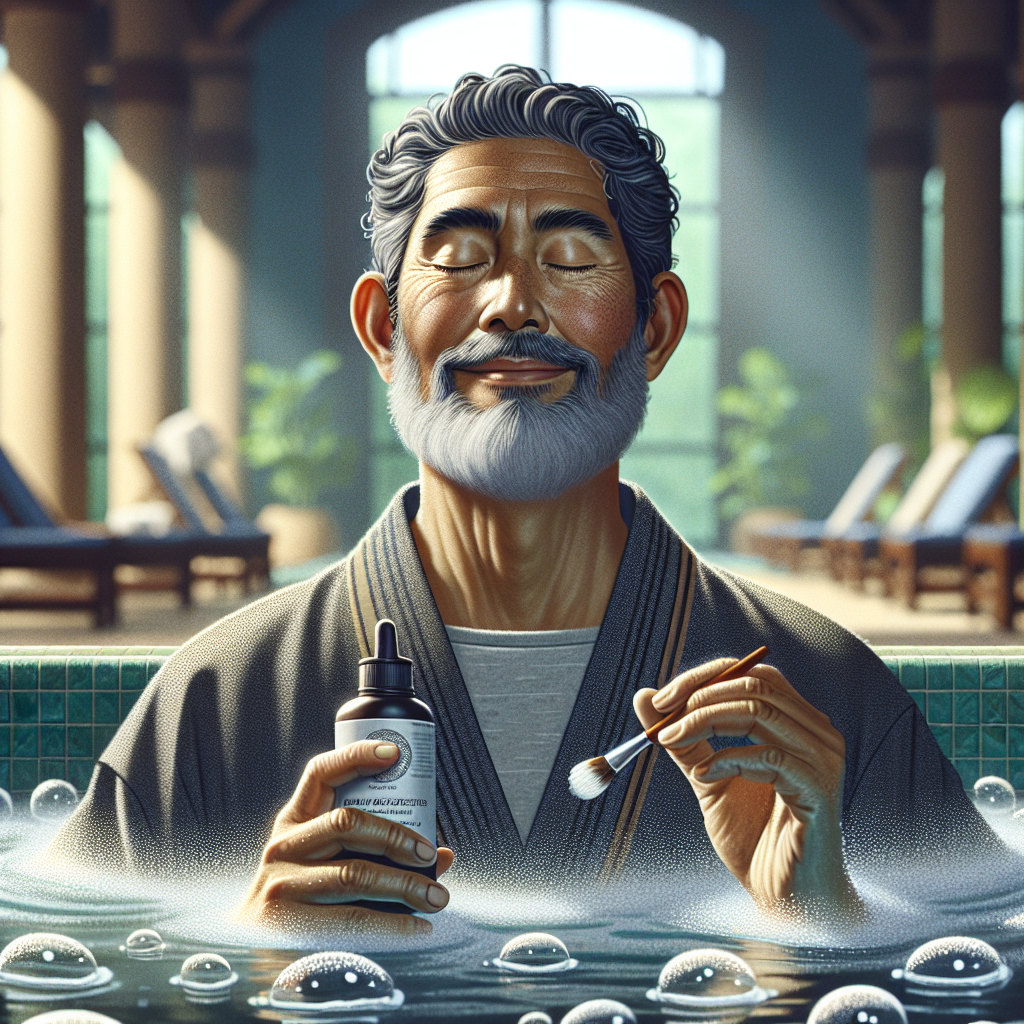
-
Hydrotherapy can reduce blood sugar levels and improve circulation, benefiting those with type 2 diabetes.
-
Warm water baths can help alleviate skin conditions common in diabetics, like dryness and infections.
-
It’s essential to keep the water clean and at a safe temperature to prevent skin damage or burns.
-
Hydrotherapy should complement a comprehensive diabetes management plan, including diet and exercise.
-
Always consult with a healthcare provider before starting hydrotherapy to ensure it’s safe for your specific health needs.
Embracing Water’s Healing Touch: Hydrotherapy for Skin Care
Imagine a gentle, soothing embrace of warm water, easing not just your mind but also offering a bounty of health benefits for your skin, especially when managing type 2 diabetes. This isn’t just a relaxing spa daydream; it’s hydrotherapy, a time-tested method that can be a game-changer for your skin care routine.
The Science of Hydrotherapy
Hydrotherapy, at its core, is the use of water to treat various conditions. For those with type 2 diabetes, this form of therapy is particularly beneficial because it can help lower blood sugar levels and enhance blood circulation. These improvements are crucial because diabetes can lead to poor circulation and nerve damage, making it harder for your skin to heal from any injuries or resist infections.
When you soak in warm water, your body’s natural response is to increase blood flow to your skin. This isn’t just a temporary boost; regular hydrotherapy sessions can lead to long-term improvements in circulation. Better blood flow means more oxygen and nutrients reach your skin, which can help it stay healthy and heal more effectively.
Hydrotherapy Methods for Diabetes Type 2 Skin Care

There are several ways to practice hydrotherapy, but for diabetes type 2 skin care, warm water baths are often the go-to method. Here’s how you can get started:
-
Fill a tub with warm water, ensuring the temperature is comfortable and not too hot.
-
Soak for about 20-30 minutes, allowing the water to hydrate your skin and open up blood vessels.
-
Add mild skin-friendly additives like oatmeal or Epsom salts if desired, to enhance the therapeutic effects.
Remember, the goal is to soothe your skin, not stress it. Therefore, always check the water temperature with your elbow or a thermometer to ensure it’s safe, especially if your diabetes affects your ability to sense heat.
Preparing for Your Hydrotherapy Session
Before diving into the warm waters of hydrotherapy, it’s important to prepare properly. First, ensure that you’re well-hydrated by drinking a glass of water. Dehydration can occur even in water, especially if you’re soaking in warm temperatures. Next, gather any skin care products you’ll use during or after the session, like mild cleansers or moisturizers. Finally, set the scene for relaxation—perhaps with some soft music or dimmed lights—to make the most of your hydrotherapy experience.
Creating a Skincare Routine
Managing type 2 diabetes means taking extra care of your skin. Start by gently cleansing with products designed for sensitive skin to avoid irritation. After your hydrotherapy session, pat your skin dry and apply a fragrance-free moisturizer to lock in hydration. This routine should be a daily ritual, morning and night, to keep your skin at its best.
Incorporating Hydrotherapy into Your Daily Regimen
To make hydrotherapy a part of your daily life, consistency is key. Choose a time of day when you can unwind undisturbed. For many, this is in the evening, when the calming effects of warm water can also help promote better sleep. Ensure that you have everything you need at hand before you begin, to maintain a relaxed state of mind throughout the process.
Steering Through the Hydrotherapy Process
Navigating the waters of hydrotherapy requires understanding what to do before, during, and after your session. Preparing your body, setting the right water temperature, and creating a calming environment are all steps that lead to a successful hydrotherapy experience.
What to Expect During Hydrotherapy
As you settle into the warm bath, you’ll likely feel an immediate sense of relaxation. Your heart rate may increase slightly as your blood vessels dilate, and your body begins to absorb the heat. This process helps to improve circulation, an essential factor in skin health for individuals with type 2 diabetes. During your soak, focus on deep breathing to enhance the therapeutic effects.
Most importantly, listen to your body. If you start to feel overheated or dizzy, it’s time to get out. And remember, while hydrotherapy is beneficial, it’s not a substitute for other diabetes management strategies like medication and diet.
Monitoring Your Skin’s Response to Treatment
After each hydrotherapy session, take a moment to assess your skin’s condition. Look for signs of improved hydration, such as reduced dryness or scaling. Also, be vigilant for any adverse reactions, including redness or irritation, and adjust your routine accordingly. If you notice any persistent issues, it may be time to consult with your healthcare provider.
Staying Afloat: Maintaining Skin Health Post-Hydrotherapy
Once you’ve dried off, apply a diabetes-friendly moisturizer to help maintain the benefits of your hydrotherapy session. Keep an eye on your skin’s condition in the following days, and if you notice sustained improvements, you’ll know you’re on the right track. Consistent care is essential for long-term skin health.
Long-term Skincare Strategies for Diabetes Type 2
Hydrotherapy is just one piece of the puzzle. To support your skin’s health in the long run, make sure to stay well-hydrated, maintain a balanced diet rich in omega-3 fatty acids and antioxidants, and keep blood sugar levels under control. These steps will not only benefit your skin but also your overall health.
Lifestyle Tips to Support Ongoing Skin Wellness
Besides hydrotherapy, regular exercise can boost circulation and aid skin health. Just be sure to choose activities that you enjoy and that suit your fitness level. Additionally, protect your skin from the sun by wearing broad-spectrum sunscreen and avoid smoking, which can exacerbate skin issues and hinder blood flow.
Charting Your Progress

Keeping a journal of your skin’s condition can be incredibly useful. Note any changes, good or bad, and the details of your hydrotherapy routine. This record can help you and your healthcare provider pinpoint what works best for your skin and make adjustments as needed.
Tracking Changes in Skin Condition Over Time
Over time, you’ll want to look for positive trends in your skin’s health. Are you experiencing less dryness? Have any sores or infections healed more quickly? These observations are a testament to the power of combining good skincare practices with hydrotherapy. If you’re not seeing the results you hoped for, don’t hesitate to reach out to a dermatologist who can offer specialized advice for your situation.
When to Consult a Professional for Skincare Management
If you notice any persistent skin issues or if your skin doesn’t respond to your current care routine, it’s time to consult a healthcare professional. This is especially important for those with diabetes, as your skin is not just a matter of aesthetics but also health. A professional can provide personalized advice and treatment options that consider your unique health needs.
Frequently Asked Questions
As you navigate the waters of hydrotherapy for diabetes type 2 skin care, questions are bound to surface. Here are answers to some of the most common queries.
1. How Often Should Hydrotherapy be Practiced for Diabetes Type 2 Skin Care?
Hydrotherapy can be practiced daily, but the frequency should be tailored to your individual skin’s response and your overall health condition. Start with two to three times a week and adjust as needed. Always consult with your healthcare provider before beginning any new treatment regimen.
2. Can Hydrotherapy be Combined with Other Diabetes Type 2 Treatments?
Yes, hydrotherapy can be a complementary treatment to your existing diabetes management plan. It works well alongside a balanced diet, regular exercise, and medication. However, always discuss with your doctor before combining treatments to ensure they work harmoniously for your health.
3. Are There Any Risks Associated with Hydrotherapy for Diabetics?
While hydrotherapy is generally safe, there are risks if not done properly. Diabetics should be cautious of water temperature to avoid burns, as diabetes can impair sensation. Also, ensure the water is clean to prevent infections. Consult your doctor for personalized advice.
4. What Are the Best Hydrotherapy Practices for Sensitive Skin?
For those with sensitive skin, it’s important to:
-
Keep the water temperature warm but not hot to avoid irritation.
-
Avoid using harsh additives in the water.
-
Limit your sessions to 20-30 minutes to prevent overexposure.
-
Moisturize immediately after to lock in hydration.
5. How Can I Measure the Effectiveness of Hydrotherapy on My Skin?
To gauge the effectiveness of hydrotherapy, monitor your skin’s condition before and after sessions. Look for improvements in hydration, healing of sores, and overall texture. Keeping a diary can help you track progress and make informed decisions about your skincare routine.



Leave a Reply